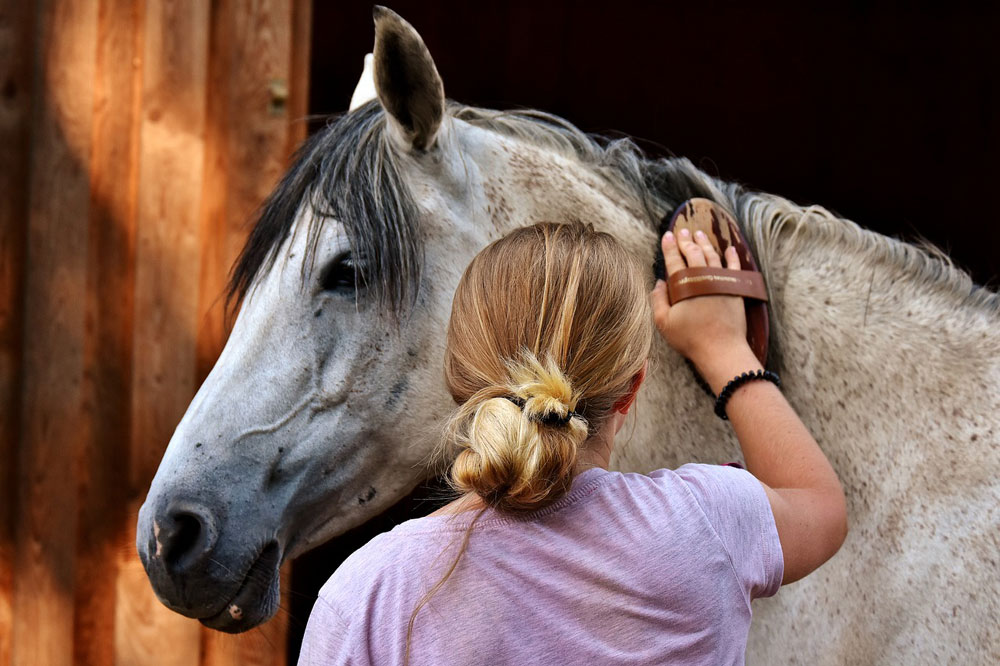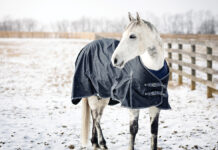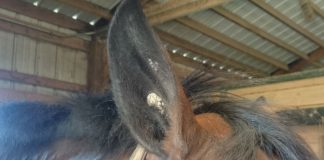Many horse owners enjoy grooming just as much–if not more so–than riding. It’s not just vain indulgence, either–grooming has real benefits for your horse’s health and well being. This hands-on time you spend with your horse gives you an opportunity to bond with him. You’ll recognize what’s normal for him, bodywise and behaviorally, and be able to detect subtle problems before they become big ones. Grooming also promotes circulation, stimulates the skin and massages the muscles.

Making your horse clean and beautiful is a satisfying feeling, and that healthy shine is an outward testament to your good care and management. Get in the grooming zone with our head to tail approach, and add a new dimension to your relationship with your horse.
Body
Here’s the body of grooming work. Three steps to basic grooming: First, curry in vigorous, circular motion to loosen shedding hair and bring dirt and dander to the surface. Next, using a brush with stiff bristles (shown above), quick, firm strokes in the direction of the hair with an upward flick at the end of your brushstroke will help whisk dirt away.
Follow with a soft brush, such as the short bristled body brush at left, using long strokes to add a shine and remove any fine dust particles that remain. Between strokes, use a curry to clean the bristles of your brush (below). For the ultimate final polish, you can even buff the coat with a sheepskin grooming mitt.
To avoid moving dirt over previously cleaned areas, it makes sense to work from front to back, top to bottom on each side of the horse in your grooming routine. And horses do like a routine. They are creatures of habit and find it comforting.
Legs
Use a soft brush and be gentle when grooming the sensitive structures of the legs. A textured grooming mitt or very soft, flexible rubber curry can be used to loosen debris if you need a more thorough cleaning.
If you see yellow botfly eggs, remove them with a slick block or blunt bot knife so that your horse doesn’t ingest and hatch these parasites.
The gnarly growths on the insides of your horse’s legs, below the knee and hock, are chestnuts. Chestnuts are not sensitive, and you can peel them down, ideally after a bath when they are soft. Growths of similar material on the back of the fetlocks, called ergots, can also be downsized for cosmetic reasons. If your horse has extremely large or tough chestnuts and ergots, you can have your farrier trim them down with nippers. Chestnuts and ergots no longer serve a purpose; they are thought to be evolutionary leftovers–remnants of the prehistoric horse’s toes.
Hooves
Picking out your horse’s hooves is the most important routine grooming task of all. This should be done daily, as well as before and after riding. Pick from back to front in the V-shaped crevice around the frog and brush away remaining dirt and debris from the sole. Also remove mud from the outside of the hoof, before it has a chance to harden into cement.
Ask your farrier about the condition of your horse’s hooves. Dry, cracked feet may need a conditioner, while tender feet may benefit from a hoof hardener. Follow your farrier’s recommendation on hoof dressings, and use products as directed.
Head
Use a small sponge or clean, damp rag to wipe any goop from the nostril, muzzle and eye area. Sponge the head after riding to remove sweat, which helps prevent fungus from developing. A small, palm-sized brush gets in the angles of the face. A soft, flexible curry or grooming mitt can be used to loosen dirt and dander.
Show horses have every last whisker and tuft of inner ear hair removed. But even if your horse lives a casual lifestyle, a little cleanup with the clippers works a bit of practical magic on his appearance:
Trimming the long hairs from the outer edges of his ears and leveling off any unsightly protruding inner ear hair will have him looking sleek while still affording him some protection against gnats and flies. Gently fold the ear together to prevent hair from falling into the ear canal. With the clippers, trim the hair that sticks out, working from top to bottom. Then run your clippers lightly down the outer edges of the ear for a clean-cut look.
Skimming the “beard” under your horse’s jawline gives him a more refined profile. The whiskers on the muzzle and long guard hairs around the horses’ eyes are also usually trimmed. However, these hairs serve an important purpose to help a horse sense his surroundings and avoid potential injuries to the eyes or face. It’s best to leave these little “feelers” if they don’t need to be removed for the show-ring. If the scraggly look drives you crazy, you can shorten the whiskers up, which looks a bit neater but is still functional to the horse.
Mane
Trimming a small section of mane behind the ears provides a place for the crownpiece of the bridle to rest comfortably. This trimmed area is called a bridlepath. As a rule of thumb, use the width of the crownpiece to guide you, although some breeds and disciplines prefer a slightly longer bridlepath. Trim carefully so that you don’t hack off more mane than intended, or cut too far into the forelock.
Never cut the length of the mane straight across with scissors—that’s the equine equivalent of a bowl cut. “Pulling” is the traditional technique used to thin and shorten the mane so that it lies naturally. Four inches is a length that looks appropriate for most English and western disciplines.
To pull a mane, grasp a small section of mane hair (about a half inch or so), holding the ends at the bottom. Using a metal pulling comb, backcomb the section so that you are left holding just the longest strands. Wrap those hairs around the comb and pull them out with a quick tug. Most horses are surprisingly tolerant of this. If your horse objects, try taking fewer hairs.
However, some horses do resent the process. It may be easier on them to do a little bit at a time each day, and pull the mane in a gradual manner. “Cheater” methods also exist. For horses with a very thin mane, where you don’t want to remove thickness, use texturizing scissors held perpendicular to the mane, and snip carefully. This way you can remove length without creating a blunt edge. Or, backcomb and use the edge of a clipper blade or thinning comb to “razor” the hair off. Handy mane pulling devices such as the ManeMaster or Solo Comb work off of this principle. All these techniques will shorten the mane with an irregular edge for the desired look.
If your horse’s mane is unruly and lies on both sides of his neck, you can tame those tresses by dampening the hair over to the correct side and putting it in big fat training braids. Be sure not to make them too tight at the crest, or they’ll itch and your horse will rub, creating a whole new problem, i.e., no mane!
Tail
There’s a fine line with grooming the tail. Too much handling causes hair loss and breakage, yet the tail must be maintained regularly or you’ll be wrestling with dreadlocks. To protect those precious hairs, start with a clean, conditioned tail, then add a dab of detangler to work through knots.
Tart detangling at the bottom with your fingers and progress upward, going strand by strand. When you can freely run your fingers through the tail, you can follow with a vented or paddle-style brush or wide-tooth comb. Traditionalists eschew brushes and combs and do all the work by hand, but modern grooming tools and products have come a long way.
The tail can be braided below the tail bone to keep it tidy and protect it from snags. A tail bag can be used for additional protection. Take the tail down once a week or so and comb out, re-braid and bag. Be sure not to leave your horse defenseless during fly season, however.
Tail rubbing may be caused by flies or gnats, internal parasites, or a dirty sheath or teat area, so be sure to investigate these health-related issues.






Thanks so much for these grooming tips! I love grooming time with my old horse, and these will make it even MORE enjoyable!
Thanks for the helpful article! I love to groom horses and these will come in handy.
I LOVE grooming my horse! And he really enjoys it. These tips were great, especially since my horse always comes in with filthy legs that are so hard to clean gently.
This is very helpful thank you!
Love the tips!!!